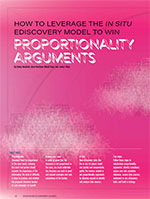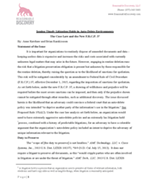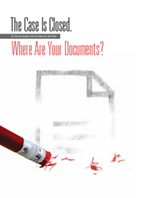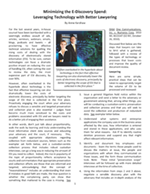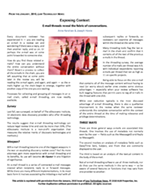How to Leverage the In Situ eDiscovery Model to Win Proportionality Arguments
The Docket, published by the Association of Corporate Counsel (ACC), October 2020. The days of expensive and unnecessary e-discovery are over – using proportionality counsel to scope discovery with screen-share interviews and in-place search, provides a lawyer who can negotiate and defend the proper scope pf discovery, reducing volumes and avoiding discovery disputes.
Anne Kershaw Bio
Anne Kershaw, Esq. LinkedIn
Reasonable Discovery, LLC
Dedicated to finding simple solutions for organizations confronting complex data management, information governance and knowledge strategy challenges.
Developments in Litigation Technology: Early Sleuthing and Scoping
The Docket, published by the Association of Corporate Counsel (ACC), October 2018. In litigation, the side that gets the earliest and best understanding of the underlying facts and how the evidence supports or undercuts key witnesses has a distinct strategic advantage. Fortunately, several trends are converging that make early case sleuthing and scoping more affordable and feasible than ever for cases of all sizes.
Issuing Timely Litigation Holds in Auto ‐ Delete Environments
LinkedIn Pulse 2016 and October 2019. It is important for organizations to routinely dispose of unneeded documents and data – keeping useless data is expensive and increases the risks and costs associated with currently unknown legal matters that may arise in the future. However, engaging in routine deletion runs the risk that a litigation preservation obligation is present but unknown by those responsible for the routine deletion, thereby raising the question as to the likelihood of sanctions for spoliation.
Iterative Legal Analysis & Sampling (“ILAS”) vs. Linear Document Review – A Comparative Case Study
Corporate E-Discovery Forum, 2016; LinkedIn Pulse, 2018. This study proves that an experienced lawyer who understands the case, the client objectives and strategy, and possessing technical analysis skills or working collaboratively with someone who has them (an “Iterative Legal Analysis and Sampling” (ILAS) approach), can find the relevant documents in litigation or an investigation, faster, less expensively and as effectively as, a team of contract review lawyers working at much lower hourly rates conducting ‘linear’ document review.
Proposed New Federal Civil Rules – Part Two (Proportionality & New Meet and Confer Requirements)
The Exchange, Jan.-Feb. 2014, published by the N.Y. Chapter of the Association of Records Managers & Administrators (ARMA). This article, the second in the series, discusses the proposed FRCP amendments relating to case management, cooperation and proportionality. Specifically, this article addresses the proposals to amend FRCP 26(b)(1), which pertains to the scope of discovery in federal litigation, the new pro- posed revisions to FRCP 16 regarding scheduling orders emanating from FRCP 26(f) “meet and confer” conferences, Rule 34 discovery requests and objections, and a new proposed FRCP 26(c) rules cost-shifting.
Proposed New Federal Civil Rules – Part One (Data Disposition & Sanctions)
The Exchange, Nov.-Dec. 2013, published by the N.Y. Chapter of the Association of Records Managers & Administrators (ARMA). The Federal Rules of Civil Procedure (“FRCP”) contain the rules pertaining to discovery in federal litigation that drive most lawyer behavior in the land of e-discovery – and the rules are a ‘changing! This article, the first of a three-part series, will address the potential effects of the FRCP 37 proposed sanctions amendments on records management and e-discovery practices.
The Case Is Closed. Where Are Your Documents?
The Docket, published by the Association of Corporate Counsel (ACC), May 2013. Corporate documents placed in the care of third parties must be accounted for. Documents neither destroyed nor returned when a case is closed represent ongoing exposure. Three steps can help to ensure that the final case closing will be routine and easily managed:
Electronic Document Lifecycle Management: Finish the Job!
The Exchange, Sep.-Oct. 2013, published by the N.Y. Chapter of the Association of Records Managers & Administrators (ARMA). Organizations are drowning in a rising tide of unnecessarily retained electronic data,1 caused by the ease with which users can accumulate and hoard data, and a fear that sanctions might be imposed if the organizations clean house. The consequences? Inflated data storage and management costs, plus greatly inflated legal review fees in the event of litigation. All without any clear understanding as to what records and information are being retained or why.
Minimizing the E-Discovery Spend: Leveraging Technology with Better Lawyering
The Woman Advocate, American Bar Association (ABA) Committee, 2012. For the last several years, in-house counsel have been bombarded with a seemingly endless assault of ads, articles, seminars, webinars, emails, blogs, podcasts and tweets – all proclaiming to have effective technical solutions for quelling the rising costs of dealing with the discovery of electronically stored information (ESI). To be sure, certain technologies can have a dramatic positive impact on reducing the cost of handling ESI, often cutting the cost to review the data, the most expensive part of ESI discovery, by over 90%.
What Lurks Within: Destroy legacy data or it can come back to haunt your company
Law Technology News, December 2011. Legacy data (backup tapes, file shares, PSTs, and other storage media) when kept indefinitely has no value or purpose. But it can create expensive havoc and costs that can be avoided if the data is properly managed, and destroyed when business and legal retention requirements expire.
Crash or Soar? Will the legal community accept “Predictive Coding?”
Law Technology News, October 1, 2010.
Document Categorization in Legal Electronic Discovery: Computer Classification vs. Manual Review
Journal of the American Society for Information Science and Technology, 61(1):70–80, 2010. The study discussed in the article demonstrates conclusively that manual document review is outdated, ineffective, and inefficient.
Ethics and E-Discovery Review
The Docket, published by the Association of Corporate Counsel (ACC), Jan./Feb. 2010. A study published by the Ediscovery Institute based on a survey of leading ediscovery providers (Deduping Survey) shows that, despite the technical ability to suppress or consolidate duplicates within an electronic document population, chances are about 50:50 that your outside counsel fails to take advantage of this technology, opting instead to double bill for reviewing unnecessary duplicates for privilege, confidentiality and relevance. The study shows that, on average, law firms that do not consolidate duplicates across custodians are reviewing 27 percent more records than needed, and in some cases 60 percent or more, raising serious ethical issues involving conflicts of interest and technical competency.
Exposing Context: E-mail threads reveal the fabric of conversations.
Law Technology News, January 2010. Processes for collecting and grouping all messages in an e-mail chain, called e-mail threading, are now readily available and provide a tremendous assist in e-discovery.
Judges’ Guide to Cost‐Effective E‐Discovery
The E-Discovery Institute, 2010. Foreword by Hon. James C. Francis IV, United States Magistrate Judge, Southern District of New York
Mandating Reasonableness in a Reasonable Inquiry
University of Denver Law Review, May 2010. Just as today’s litigators struggle with searching for relevant documents to respond to an opponent’s discovery request, fictional adversaries that existed “[a] long time ago in a galaxy far, far away” had similar trouble locating missing data tapes on a planet-sized battleship. Searching for lost items is a difficult task—especially if your search team doesn’t know what to look for.
EDD SHOWCASE: Highway Robbery? Are we cheating clients if we don’t purge duplicates?
Law Technology News, August 2009. If you send an e-mail to three people, your system keeps one copy, with all three people listed in the “To” field. If you need to see all your e-mails to just one of those people, you search for that name. It’s still just one copy. Indeed, it would be silly to have multiple copies. The same holds true for document discovery repositories, yet a recent survey suggests that lawyers still don’t “get it,” and often insist on keeping multiple, unnecessary copies.
Cost of E-Discovery Threatens to Skew Justice System
Gartner, April 2007. Anne Kershaw joins a panel of blue-ribbon legal scholars, including Supreme Court Justice Stephen Breyer and Harvard Law Professor Arthur Miller, at Georgetown’s Thought Leadership Summit, to discuss growing concerns around electronic discovery (e-discovery). Exorbitant costs and massive amounts of data are having a negative impact on society and the practice of law.
Automated Document Review Proves Its Reliability
Digital Discovery & e-Evidence Newsletter, Pike & Fischer, November 2005. Pushed by cost, time, regulatory and ethical considerations to embrace change sooner rather than later, law firms and clients are increasingly experiencing the impact of electronic discovery technologies. Staying ahead of the curve on these offerings is key to the effective management of discovery, providing the most reliable and cost effective case management for clients.
New Electronic Discovery Rules Should Help Solve Legal and Technical Problems
Digital Discovery & e-Evidence Newsletter, Pike & Fischer, October 2005. Meaningful amendments to the Federal Rules of Civil Procedure governing discovery of electronically stored information(“ESI”) were approved on September 20, 2005 by the U.S. Judicial Conference as recommended by the Conference’s Standing Committee on Rules of Practice and Procedure. The amendments will next be forwarded to the U.S. Supreme Court and, if promulgated by the Court by May 1, 2006, will take effect on December 1, 2006, unless Congress intervenes.

